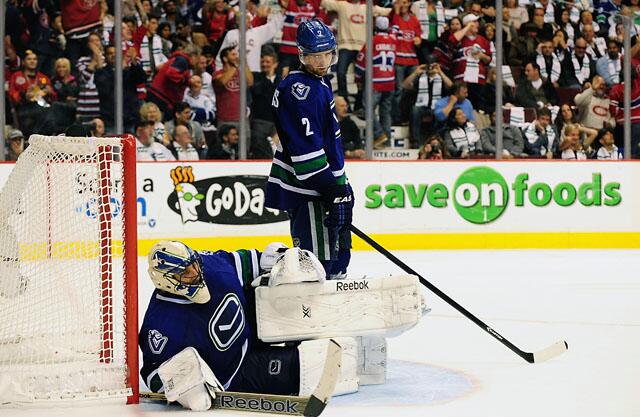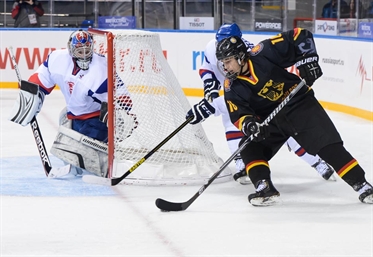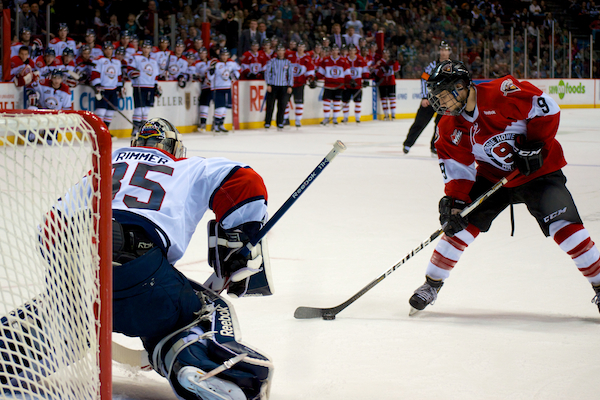 |
| No no no no no no no no no no no no no. |
Now, if you follow me on Twitter and saw what I had to say during the CHL Super Series whenever the topic of goaltending was brought up, you'll know that I'm no Craig Button when it comes to Zachary Fucale. I don't particularly think he's the best U20 goalie in Canada, and certainly shouldn't garner consideration for the World Junior starting gig. I've listed a few of the reasons why I believe this before, most notably this:
Gonna tweet this every time Shannon mentions WJC G. Save%:
E. Comrie 0.926
M. Murray 0.926
T. Jarry 0.921
J. Paterson 0.906
Z. Fucale 0.892
— Rhys J (@Thats_Offside) November 22, 2013
Basically, a goalie's only job is to stop the puck. Zachary Fucale is bad at stopping the puck. Therefore, Zachary Fucale is bad at his job and shouldn't be on the World Junior team. It's not difficult logic to follow, but for some reason, logic seems to have completely abandoned Ryan Jankowski and the rest of the Hockey Canada decision makers, as they're citing stuff like Fucale's "ability to win."
RJ - Fucale resume speaks for itself, being able to win is an advantage when playing WJC RT: @MattTheWebGuy1 How good shot does Fucale have?
— CanadianHockeyLeague (@CHLHockey) November 21, 2013
Now, a couple of very reasonable people who I know understand my point have put forth some arguments in support of Fucale as a WJC goalie. They are as follows:
@Thats_Offside Not 100% sure on this but isn't the average QMJHL shooting percentage higher than the other leagues? Something to consider.
— Arik Parnass (@ArikParnass) December 2, 2013
@Thats_Offside @mc79hockey actually his career sv% isn't half bad when you compare Jarry/Comrie/Patt/Fucale to their league avgs, but
— Garret Hohl (@garrethohl) December 2, 2013
@Thats_Offside @mc79hockey Comrie +0.00952 Jarry +0.01750 Patterson +0.02683 Fucale +0.04526; Reg season sv% rel to their lg 2011-12 lg avg
— Garret Hohl (@garrethohl) December 2, 2013
Basically the statistical argument in favour of Fucale is this: the QMJHL has a worse save percentage on average, so Fucale is just as good relative to the rest of his league as Eric Comrie, Tristan Jarry and Jake Paterson have in theirs. I'll explore this in a minute, but first I'll quickly go over why I ignore wins and GAA when evaluating goalies.Goals against average is the average number of goals scored on a goalie per 60 minutes of play. It can be found by this formula:
(Total Goals Against/Total Time On Ice)*60
([Total Shots Against*1 - Save Percentage]/TOI)*60
As you can see, a goalie doesn't have any control over half of GAA, and the other half is just save percentage. Tracking GAA then only serves to add useless and irrelevant information when looking solely at goalies.
Wins are much the same, except now goals for are added to the picture. Bill James' expected win formula as it applies to hockey is Goals For^2/([Goals For^2]+[Goals Against^2]). Again, a goalie can't control the vast majority of what goes on in a win. The only part he can control is the number of shots he stops, which is his save percentage. It's for these reasons why I don't put a lot of stock into "knowing how to win games." It's especially relevant in Fucale's case because last year's Halifax Mooseheads probably could have won with 2013 John Garrett in goal. They basically crushed the rest of the QMJHL last year in score close possession, as illustrated by this data dug up by Josh Weissbock:
Having a team with two super-elite finishers in MacKinnon and Drouin, and that can tow nearly 60% of possession is ridiculously dominant. Having a huge season under those circumstances is less "knowing how to win games" than it is "having four functional limbs and a pulse."
Anyways, on to more relevant stuff. The prevailing argument in favour of Fucale is that he's as good relative to the QMJHL as Eric Comrie and Tristan Jarry are to the WHL and Jake Paterson is to the OHL. To see if this is true, I took the average save percentage over the last 3 years in each league, and compared each goalie's career CHL save percentage to this baseline. Here are the results:
Even with a league average save percentage more than 10 percentage points lower than both the WHL and OHL, Fucale only performs 97 basis points (0.97%) of save percentage better than the rest of his league. By contrast, both Comrie and Jarry perform far better compared to their peers, while Paterson lags behind the OHL.
I'll touch on this next bit a little more later, but I suspect the reason for a depressed QMJHL save percentage doesn't have anything to do with the quality of shooters or coaching systems or anything, but just fewer good goalies. For some reason, the QMJHL only developed 3 legitimate NHL goalies in the decade between 1999 and 2008, and none of those guys are really above NHL average for a starting goalie. Anyways, if you assume all leagues are of equal player talent, you can take a Canada-wide average of save percentages and compare all goalies against that baseline. Here are the results of that:
Okay, this is a little math-y now so bear with me. The Z-scores in the above table are a standard score. They measure how many standard deviations above the mean a given number is. A Z-score of 0 means average, below 0 is below average, and above 0 is above average. A score of 1 here would mean that a goalie's save percentage is better than 84% of those save percentages posted in the three year sample of games I looked at.
Long in short, Eric Comrie and Tristan Jarry score better than 90-95% of all CHL goalies. Jake Paterson is better than about 60% of all CHL goalies. Zachary Fucale is just barely above CHL average. In a cap-less system with no constraints on players, Hockey Canada passed on two elite performers to take two average ones.
So let's review the findings here:
1) Eric Comrie and Tristan Jarry are better than their respective league more so than both Fucale and Paterson.
2) Fucale's baseline comparison was easier, yet he still couldn't outperform it as much as his competitors.
3) Using a constant baseline for all goalies, Comrie and Jarry were found to be elite, while Paterson and Fucale are just slightly above average.
But wait, there's more.
I feel like I'm piling on Zach Fucale at this point. I really don't mean to, but I think it's important to get this point across: he probably isn't good enough to be an NHL goalie. Similar to what I did with those defenseman posts back around the draft, I looked at the 10 year window between the 1999 and 2008 NHL entry drafts to see which goalies that came from the CHL turned out to be NHL-calibre players. In all, 120 goalies were drafted out of the CHL; 39 from the WHL, 47 from the OHL, and 34 from the QMJHL. Of this sample, just 15 goalies turned out to be what I consider an NHL regular. Here's the whole list:
The takeaway here is that guys who went on to be anyone of consequence in the NHL were all extremely good to elite junior performers. Zachary Fucale is neither extremely good or elite. He is average. And average CHL'ers don't make it to the NHL in any kind of significant capacity, despite what scouting reports like this will tell you.
To sum this all up, leaving one of Tristan Jarry or Eric Comrie off the World Junior team would be a poor decision. Leaving both off in favour of Fucale and Paterson is indefensible. Despite this, Canada should still win the gold medal because the talent level in this country is so much better compared to every single nation in the world that it should be nearly impossible to screw up. Yet Hockey Canada somehow has for five years now, and it's decisions like these that prioritize "heart" and "grit" and "winningness" over "ability to play hockey" that play a major role in those failures.

























